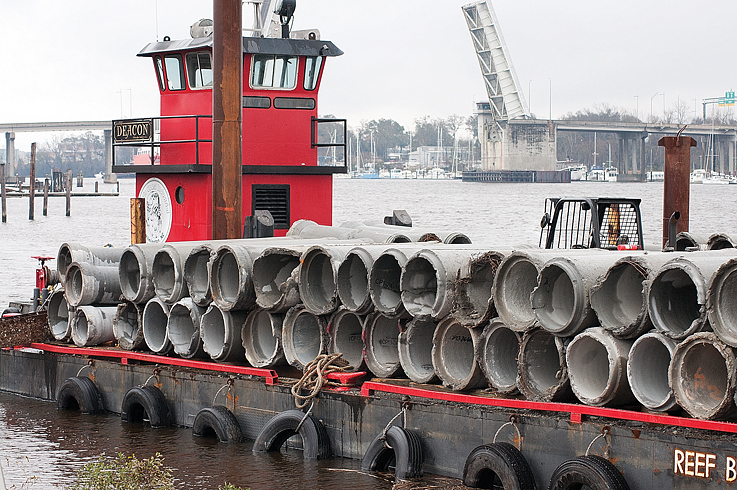Over the next couple months, more than 2 million tons of concrete material will be dropped over local artificial reefs, providing habitat for ocean life on barren stretches of the sea floor.
Working with N.C. Division of Marine Fisheries staff, a barge dropped two loads of concrete pipe over the Liberty Ship reef, also known as the Meares Harriss Reef, on Feb. 17 and Feb. 20. The pipe joins old tugs, barges and thousands of tires at the reef site, located about 3.5 nautical miles from the Masonboro Inlet sea buoy.
Funded with a $637,500 N.C. Coastal Recreational Fishing License grant and private funding from the Bruce Barclay Cameron Foundation, the Onslow Bay Artificial Reef Association has been working with Atlantic Coast Industrials and the Division of Marine Fisheries for about one year to execute the project. Three other local reefs are poised to benefit from the project: the Billy Murrell Reef off the coast of Topsail Island, the Bruce Barclay Cameron Reef (also known as the Five-Mile Boxcar reef) off of Masonboro Inlet and the Phillip Wolfe Reef Complex off of Carolina Beach Inlet.
Unfavorable temperatures, wind speeds and water conditions have thwarted early deployment plans, said Division of Marine Fisheries biologist Gregg Bodnar, who is overseeing the project. The weather could also slow colonization of the materials, he added. Lower-level growth like barnacles, algae, seaweed and mussels that attracts large fish populations to the reefs will start in the spring, after the water warms up, but fish might immediately notice the activity and explore the new structures.
“They see that disturbance in the water, that there’s something new in the water that wasn’t there before, and as curious creatures, they’ll go in and investigate,” Bodnar said. If it does not provide refuge or sources of food, Bodnar said the fish might leave but return as the reef site matures.
Artificial reef association executive director Rita Merritt said it was a priority to invest the grant money and donations back into the local economy, hiring Wilmington-based marine construction company Atlantic Coast Industrial as contractor for the project. Atlantic Coast Industrial owner David Brinkley also designed the Atlantic Pod, an experimental new reef enhancement structure used for the first time on the four local reefs. Each reef will receive 50 pods and approximately 500,000 tons of concrete pipe over the course of about 20 total deployments. Brinkley estimated they should finish deploying by May.
For a year or two after deployment, the Division of Marine Fisheries will work with the University of North Carolina’s Institute of Marine Science to monitor the performance of the pods, looking at two main criteria to determine if the pods will be approved for use at other sites: how long the materials last underwater, and whether the materials stay where they were placed.
The artificial reef association is working with Atlantic Coast Industrial to offer memorial pods, which will be engraved and affixed with a plaque commemorating the donation required to secure a memorial pod. Brinkley and Merritt plan to deploy the memorials over the Bruce Barclay Cameron Reef. The proceeds will help the association pursue local reef enhancements. For more information about memorial pods, email Merritt at [email protected]
email [email protected]




